

The Sky Tech Handheld Laser with two barrel lock keys
The is the laser in the case. Batteries are not included.
Sky Techologies 100mW Handheld 445nm Blue Laser
Sky Techologies - SkyTechLasers.com
 |
 |
|
The Sky Tech Handheld Blue Laser - 445nm - 100
mW The Sky Tech Handheld Laser with two barrel lock keys |
The Sky Tech Handheld Blue Laser - In the Case The is the laser in the case. Batteries are not included. |
Laser pointers. What once was unusual to see during nighttime observing sessions for astronomy has now become commonplace. The use of laser pointers has often been abused by some amateur astronomers, leading to limitations and even restrictions on their use at Star Party events. I use laser pointers frequently and have reviewed several other laser pointers. My review of this laser is unbiased.
NOTE: A laser pointer is not a toy, it is a tool. This review treats it as such, and I hope that anyone reading this review will understand that using a tool with these capabilities should be handled with the utmost respect for the tool and for everyone around them. This laser is never to be used for games or in a reckless manner. It should never be pointed at any person, animals, moving vehicles, or aircraft.
I was contacted by Sky Technologies ( http://www.skytechlasers.com ) to test one of their new laser pointers in the blue color spectrum. I have never tested a laser pointer in the blue range of approximately 445nm, so that alone had me interested. I responded and they gave me a choice of reviewing either their 100mW handheld blue laser or their 80mW Blue Laser Pointer that has more of the traditional thin body. I decided to test their 100mW Handheld Blue Laser.
First Look
After a brief wait for delivery, I received the new Handheld Blue Laser in the mail. It was well packaged and the handheld laser was in a sturdy vinyl box. The box was covered in very nice leather-looking vinyl and containing a cut foam insert. However, the insert was cut for the body of the laser pointer without the battery cover attached. So, to store the handheld laser, you must remove the battery cover. Overall, this is not a critical issue, and removing the batteries from the laser during storage is probably a good idea anyway. It requires a small amount of time to put the unit together before use and that could be an issue in low light levels. The case is large enough to hold the handheld laser with the battery cover attached and batteries inside, but the foam would need to be cut in the case to allow the handheld laser to be stored in one piece. Also included with the handheld laser was a lanyard with two keys to unlock the laser body, and a 3.5 mm tip sleeve plug that can be wired into a system that will allow remote operation of the laser.
The handheld laser came with the laser body and battery end cap. Batteries were not provided so I immediately ordered two sets of UltraFire 16340 1200mAh 3.6V Lithium Ion batteries. While they were on order, I decided to buy a couple of Duracell 123 non-rechargeable lithium batteries to try it out. The 123 batteries were rated at 3V, but showed 3.2V when placed into service. Initial inspection of the handheld laser body indicated that it was made of aluminum and anodized in black coating. It is slightly more than 23mm (0.9”) in diameter, 184mm (7.25”) long, and weighs 172g (6.1 oz) with batteries installed. Although not heavy, this handheld laser has enough heft to keep you aware of what pocket you are keeping it in. The body of the laser has several labels containing information and warnings. The largest label on the body is placed right above the pressure activated one click on, one click off button. This label warns that this laser is intended for laser professionals and those over the age of 18 years old. It also clearly states the duty cycle of this laser at 5 to 10 min. of use, with at least a 1 min. rest period. The label also has an OSHA danger placard warning of direct exposure to the laser beam, and it stated wavelength range of 405 to 450 nm. A label below the locking system shows compliance with the FDA, RoHS, and CE Conformity. A white label right above the removable battery cap is printed with the model number and serial number for the handheld laser.
At the tip of the laser body there are two knurled rings. The top ring is a slightly rotating inset cover for the lens of the handheld laser. The knurled ring below that can be rotated to move the lens away from the laser body to modify the beam dispersion. The beam can be widened to a large degree, almost to act like a flashlight. The ability to modify the beam allows the user to minimize the concentrated intensity of the light. The laser body has a barrel keylock mounted about halfway down the body of the handheld laser. This barrel keylock allows the user to secure the laser from use by others. This is an excellent feature, especially for laser pointers that have this level of power. The center of the barrel lock is indented with an arrow. When the arrow is pointed perpendicular to the long axis of the handheld laser, the laser is locked and cannot be used. The laser can also be rendered nonfunctional by removing the 3.5 mm safety interlock plug located on the bottom of the laser body on the battery cap. For the laser to function, the 3.5 mm safety interlock plug must be inserted into the base of the laser body and the barrel keylock must be rotated so the arrow on the keylock is pointing along the axis of the laser body toward the laser opening, the cover over the laser lens rotated to the open position, and the red on/off button depressed which illuminates a small red LED above the on off button. At that point the beam can be focused by the user to suit their particular needs.
 |
 |
|
The Laser Barrel Lock in Locked Position
|
The Laser Barrel Lock in Unlocked Position
|
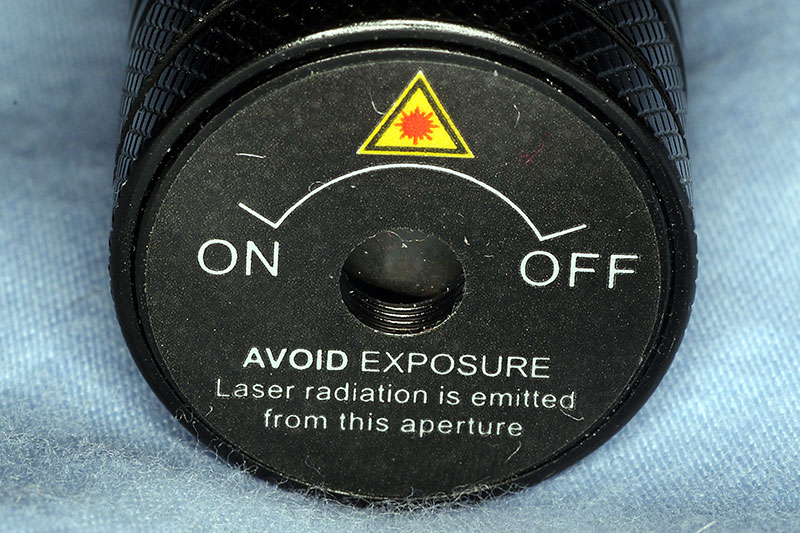 |
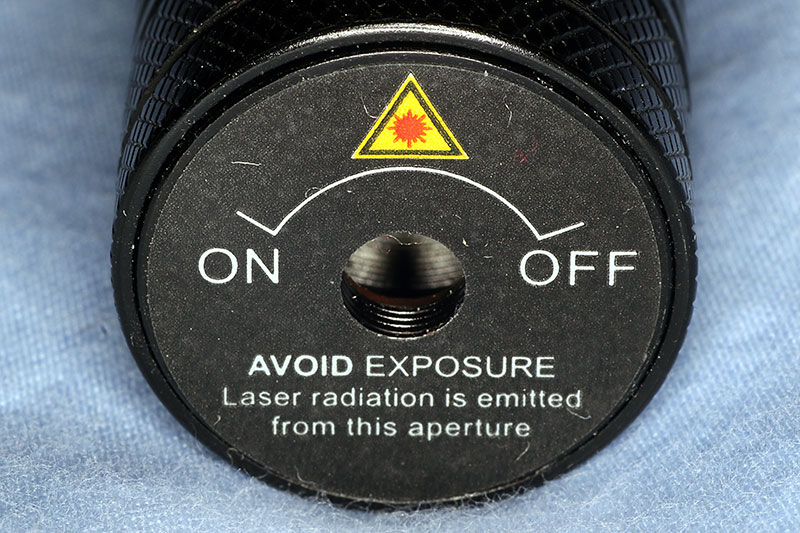 |
|
The Aperture Cover in Closed Position
|
The Aperture Cover in Open Position
|
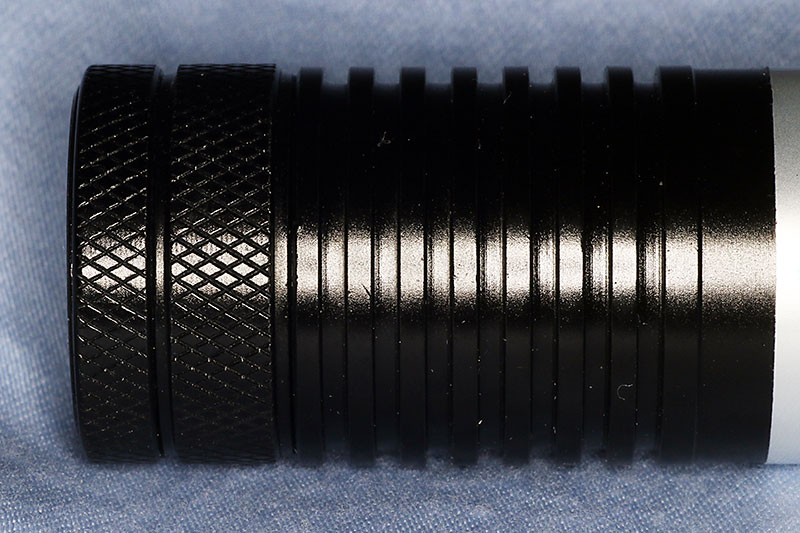 |
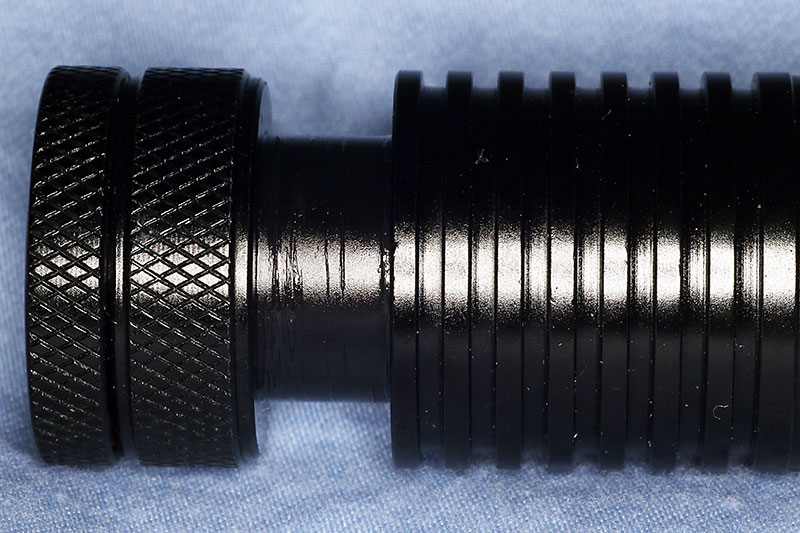 |
|
The Focus Ring in Narrow Beam Position
|
The Focus Ring in Wide Beam Position
|
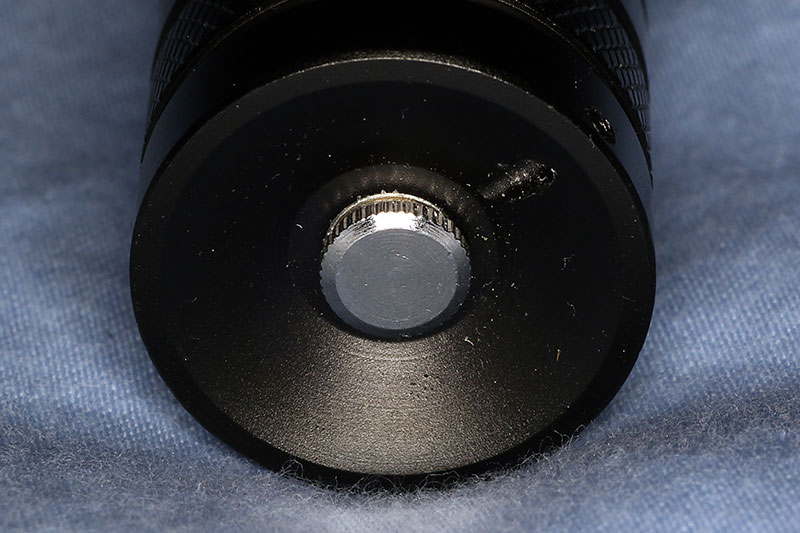 |
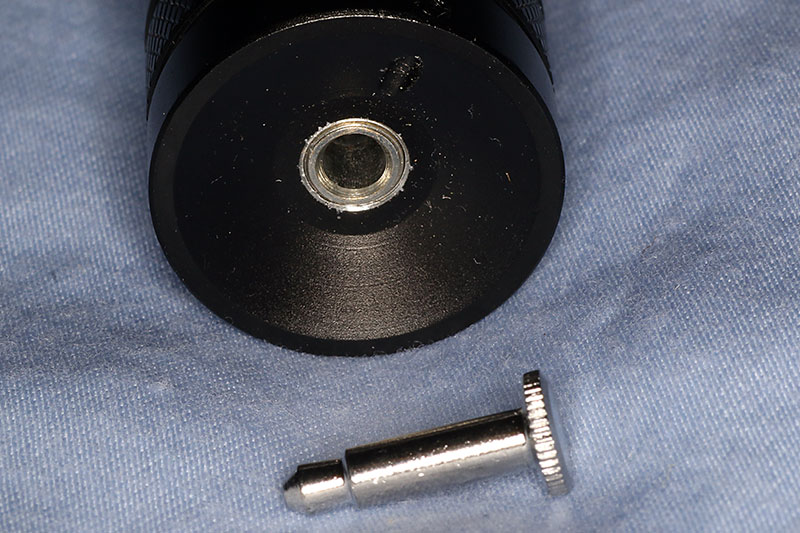 |
|
The Safety Plug in Active Position
|
The Safety Plug in Inactive Position
|
In Use for Astronomy
Sky Technologies asked me to review this handheld laser for astronomical purposes. I am heavily involved in astronomy outreach programs, so I use a laser pointer to point out objects in the night sky on a regular basis. I recently used the 450 nm blue laser at an outreach program. I loaded the batteries in the handheld laser and used the supplied keys to turn the barrel lock for operation. Unlocking this laser takes a bit of getting used to, but it is a very good safety feature. Now, most people figure that whenever you break out a laser pointer to show them the night sky, it is most likely going to be red or green. When I turned on the blue laser, a solid round of "oohs" and "aahs" emanated from the group of attendees. I answered numerous questions about the blue laser and demonstrated its ability to widen the beam through focus before continuing with the astronomy outreach program. I have another laser pointer rated at 55 mW at 532 nm, a green laser. I switched to the green laser part way through the program and asked which laser pointer they liked better. It seemed to end up being purely a preference of color. It is notable that the brightness of the beam of the 100mW SkyTech handheld laser at 445nm is similar to the brightness of the beam of the 55mW laser pointer at 532nm. This makes sense as the dark adapted eye is at least twice as sensitive to light at 532nm than it is at 450nm, and it would take at least twice the output at 450nm equal the brightness of a beam at 532nm. It did take a little bit of getting used to the one click on/one click off button to activate the laser. Also, several times when I put the laser in my coat pocket, I did not lock the laser only to find that I had bumped the on off button while it was in my pocket and turned on the laser. Fortunately, it was bright enough that I could see it was turned on while still in my pocket. Lesson learned the hard way. Now that I had the chance to use the 100mW SkyTech Handheld Blue Laser for astronomical observing, I once again closely went over the design, build, and use of this handheld laser and some bench tests. When I tested the brightness of the diffused beams to my instruments, my visual observations were confirmed. The instruments, when set to read like the human eye, the Green beam at 532nm and 55mW registered almost 4 times brighter than the 445nm Blue beam at 100mW. However, the beams still appeared to be similar in overall brightness when used side by side at night. So, if you order one of these handheld lasers, keep in mind that a 50mW Blue laser will appear dimmer than a 50mW Green laser.
 |
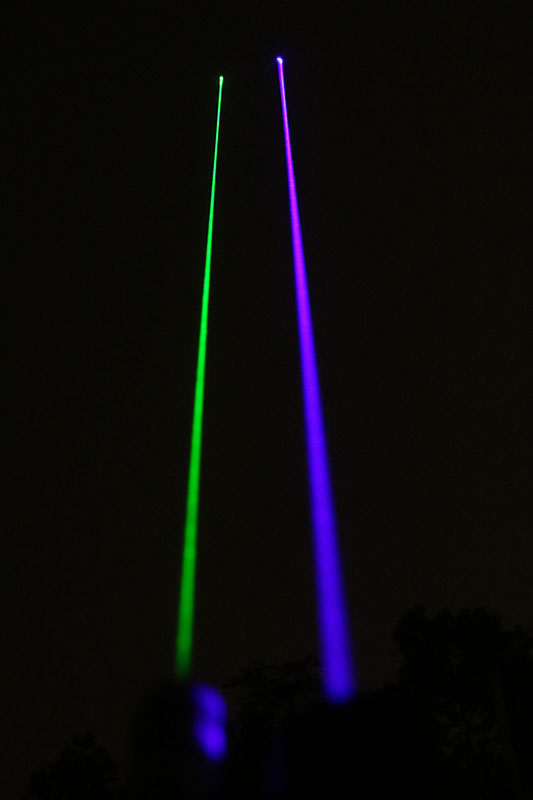 |
|
The Sky Tech Handheld Blue Laser - Beam Range The Sky Tech Handheld Blue Laser has a focusing capability. These images show the most narrow beam at the top and the widest beam on the bottom. |
100mW Blue
Laser and 55mW Green Laser This image shows the Sky Tech 100mW Handheld Blue Laser next to a 55mW Green Laser You can see that they are similar in brightness, even though the blue laser is almost twice the power. This is due to the eye being more sensitive in the green range of the spectrum. |
Results and Recommendations
I really do like this handheld laser. It is very sturdy, well made, and relatively efficient in its battery use. Using the rechargeable 16340 lithium-ion batteries definitely produces a brighter beam than the nonrechargeable 123 lithium batteries. I like the fact that you can focus and/or defocus the beam for your intended usage. I wish the focuser assembly was a little tighter when in operation. The rotating end cover worked well and was very handy in protecting the lens assembly from unnecessary exposure to damage. A welcome addition to the rotating cover would be the ability to secure it in either a full open or a full closed position. The rotating barrel lock assembly seems very sturdy and worked well. The arrow impression on the center of the barrel lock definitely helped in determining whether the laser lock was turned on or off. Once I left the laser on a couple of times in my pocket, I realized that a method of attaching the 3.5 mm security plug to a wrist band of some sort might be a good way to keep the laser from turning on in your pocket without having to disable the laser using the barrel lock key. For laser pointers, I'm a much bigger fan of momentary switches to activate the laser than I am to toggle switches. However, it certainly is not a deal killer for this handheld laser. The switch, with its accompanying LED lamp, seems very sturdy and reliable.
Bottom line
This 100mW Handheld 445nm Blue Laser is currently listed at $99. Can I recommend this laser at that price? The answer is a solid YES! This is an excellent product. It is well made, of good design, and performs much better than I expected at that price point. Although I tend to prefer the thinner and lighter laser pointers, this handheld laser with its size and weight was still an absolute pleasure to use to point out objects in the night sky. Those who use portable lasers on their telescopes to target objects might find this larger handheld laser a better choice. It is slightly heavier, but likewise, much sturdier than a pen-based laser pointer. If you are looking for a good, Handheld Laser, SkyTech Lasers is a fine choice.
Michael Overacker